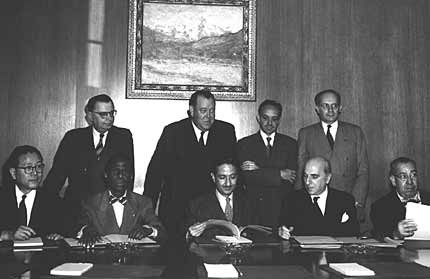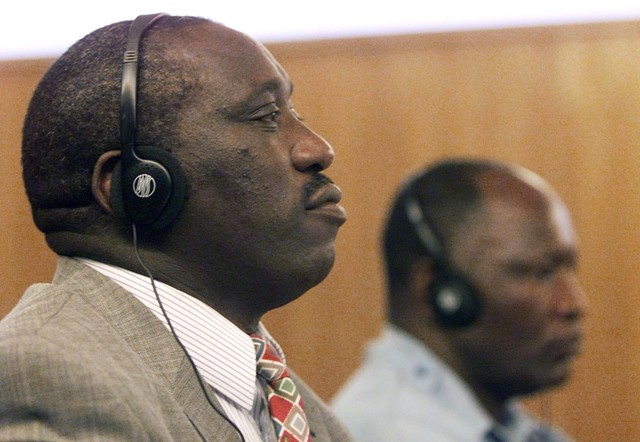Incitement to Genocide in International Law
In the immediate aftermath of World War II, the world was faced with a challenge—how to seek justice for an almost unimaginable scale of criminal behavior, including the annihilation of European Jewry. Even as a vocabulary emerged to describe the atrocities that would come to be known as the Holocaust, legal experts sought to establish a new body of law to address the unprecedented crimes perpetrated by the Axis powers. A series of war crimes trials convened by the Allied powers and European governments sought to answer tangled questions of guilt, punish the perpetrators, and deter future crimes on this scale.

The trial of leading German officials before the International Military Tribunal (IMT), the best known of the postwar war crimes trials, formally opened in Nuremberg on November 20, 1945, only six and a half months after Germany surrendered. Among the 24 defendants was Julius Streicher, publisher of the antisemitic German weekly Der Stürmer. On October 1, 1946, the IMT convicted Streicher of crimes against humanity in connection with his incitement to the mass murder of Europe's Jewish population. Streicher was executed for his crimes. At the time of the IMT, incitement to murder and extermination was considered a form of persecution on political and racial grounds, punishable as a crime against humanity. By holding one of Nazi Germany’s chief propagandists responsible as an accomplice for the destruction of the European Jews, Streicher’s conviction established a precedent-setting link between inflammatory speech and criminal action in international law. Soon after the IMT had completed its mission, direct and public incitement to commit genocide became a crime under international law.
Defining a Crime
The term “genocide” had been coined in 1944 by Raphael Lemkin, a Polish-Jewish lawyer who had fled to the United States. After the war, Lemkin and others lobbied at early sessions of the United Nations for the crime of genocide to become part of the emerging field of international law. On December 9, 1948, the United Nations General Assembly adopted the “Convention on the Prevention and Punishment of the Crime of Genocide” (commonly referred to as the Genocide Convention). Building on the intellectual and legal foundation laid by the IMT in the Streicher decision, Article III (c) of the Genocide Convention declares that “direct and public incitement to commit genocide” is a crime.

Generally speaking, “incitement” means encouraging or persuading another to commit an offense by way of communication, for example by employing broadcasts, publications, drawings, images, or speeches. It is “public” under international law if it is communicated to a number of individuals in a public place or to members of a population at large by such means as the mass media. Among other things, its "public" nature distinguishes it from an act of private incitement (which could be punishable under the Genocide Convention as “complicity in genocide” or possibly not punishable at all). Incitement to genocide must also be proven to be “direct,” meaning that both the speaker and the listener understand the speech to be a call to action. Prosecutors have found it challenging to prove what “direct” may mean in different cultures, as well as its meaning to a given speaker. Moreover, public incitement to genocide can be prosecuted even if genocide is never perpetrated. Lawyers therefore classify the incitement to genocide as an “inchoate crime”: a proof of result is not necessary for the crime to have been committed, only that it had the potential to spur genocidal violence. It is the intent of the speaker that matters, not the effectiveness of the speech in causing criminal action. This distinction helps to make the law preventative, rather than reactive.
Incitement to Genocide in Rwanda
The incitement provision of the Genocide Convention took on new importance in the wake of genocide in the African nation of Rwanda. Between April and July 1994, members of the Hutu majority, wielding machetes, firearms, and other weapons, killed as many as one million people. The vast majority of the victims were members of the Tutsi minority.
In 1997, the United Nations International Criminal Tribunal for Rwanda (ICTR) indicted three Rwandans for “incitement to genocide.” One was Hassan Ngeze who founded, published, and edited Kangura (Wake Others Up!), a Hutu-owned tabloid that in the months preceding the genocide published vitriolic articles dehumanizing the Tutsi as inyenzi (cockroaches), although never called directly for killing them. Also indicted were Ferdinand Nahimana and Jean-Bosco Barayagwiza, founders of a radio station called Radio Télévision Libre des Mille Collines (RTLM) that indirectly and directly called for murder, even at times to the point of providing the names and locations of people to be killed. In the days leading to and during the massacres, RTLM received help from Radio Rwanda, the government-owned station, and programs were relayed to villages and towns throughout the country by a network of transmitters operated by Radio Rwanda. At the heart of the Rwanda “Media Trial” that opened on October 23, 2000, was the issue of free speech rights. “A key question is what kind of speech is protected and where the limits lie,” said American lawyer Stephen Rapp, the case's senior prosecutor for the Tribunal. “It is important to draw that line. We hope the judgment will give the world some guidance.”
In December 2003, the ICTR handed down its verdict. The three judges (a South African, a Sri Lankan, and a Norwegian) convicted Ngeze, Nahimana, and Barayagwiza for direct and public incitement to genocide. The judges declared: “Without a firearm, machete or any physical weapon, you caused the deaths of thousands of innocent civilians.” In framing their verdict, the judges noted: “This case raises important principles concerning the role of the media, which have not been addressed at the level of international criminal justice since Nuremberg. The power of the media to create and destroy fundamental human values comes with great responsibility. Those who control the media are accountable for its consequences.” The prosecutors proved the “direct” nature of the incitement by establishing that the defendents used euphemisms, such as the phrase “go to work,” as calls to kill the Tutsi. That an individual or group killed someone in response to the radio broadcasts or newspaper articles was not required to prove the incitement to genocide charge.
In January 2007, the lawyers for the defendants in the Rwanda “Media Trial” appealed the tribunal’s decisions on numerous grounds. Issuing a decision on November 28, 2007, the Tribunal affirmed the charge of “direct and public incitement to commit genocide” for Ngeze and Nahimana. The judges reversed the finding of guilt on this charge against Barayagwiza, ruling that only RTLM broadcasts made after April 6, 1994 (when the genocide began), constituted “direct and public incitement to commit genocide,” and that Barayagwiza no longer exercised control over the employees of the radio station at that time. (The Tribunal did affirm the findings of guilt against Barayagwiza on different grounds, for instigating the perpetration of acts of genocide and crimes against humanity.) Because of the reversal of some charges against the three defendants, the judges lowered the defendants’ sentences: Nahimana’s from life to 30 years, Negeze’s from life to 35 years, and Barayagwiza’s from 35 to 32 years.
Hate Speech versus Incitement to Genocide
What is the difference between hate speech and direct and public incitement to commit genocide? The Rwanda Media Case emphasized that incitement to commit genocide required a calling on the audience (be they listeners or readers) to take action of some kind. Absent such a call, inflammatory language may qualify as hate speech but does not constitute incitement. In many jurisdictions hate speech itself has been criminalized.

Demonstrating that speech meets the legal threshold for the “direct” element of the incitement charge can be extremely complex. Proving such directness often involves a careful parsing of metaphors, allusions, double entendres, and other linguistic nuances: a mode of speech may be perceived as direct in one culture, but not in another. Consider, for example, the Trial Judgment in the case of Prosecutor v. Simon Bikindi, handed down by the ICTR on December 2, 2008. Simon Bikindi was a famous composer and singer from Rwanda who distinguished himself in the run-up to the 1994 genocide by using his music and fame to drum up support for the Hutu-led regime, and by fostering ethnic hatred throughout the carnage. He was also accused of incitement for composing and performing songs like Nanga Abahutu (“I Hate These Hutu,” an anti-Tutsi song). According to prosecution witnesses who appeared before the ICTR, Bikindi’s song was not only an invitation to hate Tutsi, but given the context of the ongoing civil war, to be ready to kill them as well.
The ICTR Trial Chamber was not in the end persuaded that Bikindi’s songs amounted to incitement to commit genocide. Instead, the judges convicted Bikindi for statements that he made—via loudspeaker—in the Rwandan countryside during the genocide (where he asked his audiences, among other things, “Have you killed the Tutsi here?” and referred to Tutsis as “snakes.”). The Bikindi case illustrates that a sophisticated understanding of cultural context—notably linguistic usage and subtlety—is critical for the legal determination of the directness of any alleged incitement to genocide.
In contrast to the Rwanda Tribunal, the international crime of direct and public incitement to commit genocide has played virtually no role in the prosecution of genocide at the International Criminal Tribunal for the Former Yugoslavia in The Hague. There the prosecution of atrocities other than genocide has predominated the proceedings. Most experts believe that mass communication in the former Yugoslavia was employed chiefly for spewing hate propaganda, rather than incitement to commit genocide as defined in strictly legal terms.
Incitement to Genocide in Recent Legal Debate
The crime of incitement remains firmly in place on the international legal stage. In 1998, an incitement provision was included in Article 25(3)(e) of the Rome Statute of the International Criminal Court (in conjunction with Article 6—Genocide). And on November 28, 2008, after seven years of negotiations, the European Union (EU) adopted a Framework Decision on combating racism and xenophobia. The document’s principal contribution is the EU-wide prohibition of public incitement and hatred against persons of a different race, color, religion, or national or ethnic origin, punishable by a prison sentence of one to three years. This document also prohibits public approval, denial, or gross trivialization of international crimes, notably genocide, and is an outgrowth of pre-existing European laws prohibiting Holocaust denial.
Critical Thinking Questions
Is there a direct link between words and actions? Can words and images inspire people to commit acts of genocide?
How can knowledge of the events in Germany and Europe before the Nazis came to power help citizens today respond to threats of genocide and mass atrocity in the world?
How can individuals and leaders recognize and respond to indications that a country is at risk for genocide or mass atrocity?
Explore the motives and pressures that led individuals to abandon their fellow human beings—or to make the choice to help.

